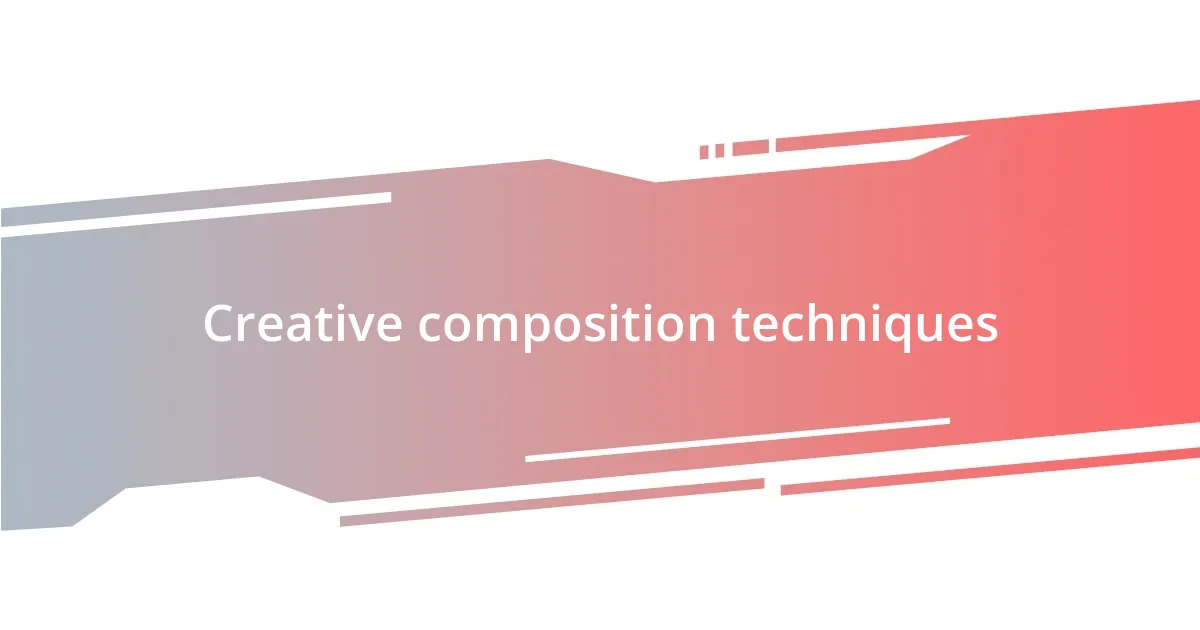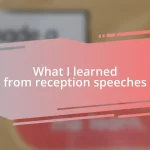Key takeaways:
- Reception photography captures spontaneous, emotion-filled moments that define the celebration.
- Preparation, including timeline coordination and vendor communication, is key to fluidly documenting key moments.
- Utilizing creative composition techniques, such as the rule of thirds and framing, enhances storytelling in photographs.
- Post-processing adjustments, including exposure, color correction, and sharpening, elevate the final images and convey the scene’s mood.

Understanding reception photography
Reception photography is all about capturing those precious moments when the celebration truly comes alive. Some of my favorite memories as a photographer come from those spontaneous dance floor shots, where the joy of the moment just radiates. Isn’t it fascinating how a simple photograph can evoke the laughter and energy felt in the room, even years later?
One time, I remember a couple who let loose during their reception, and my camera was right there to document it all. Their carefree spirit shone through every image—watching their friends and family join in the fun reminded me just how pivotal the reception is to the wedding experience. It’s in these moments, bursting with emotion and candid interactions, that we see the heart and soul of the event.
Understanding reception photography means knowing when to be unobtrusive and when to step in to catch those up-close emotions. Think about it: isn’t it rewarding when the couple looks back on their photos and remembers not just the day, but the feelings behind each snapshot? By capturing both the big moments and the little details, I aim to create a comprehensive visual story that reflects the essence of each unique celebration.

Importance of preparation
Preparing for a reception is like laying the foundation for a great story. I can’t stress enough how essential it is to map out the key moments you want to capture. A few months ago, I had a client who hadn’t shared their timeline until the week before the wedding. Let me tell you—it resulted in a chaotic guessing game during the reception! When you’re well-prepared, you can seamlessly anticipate the highlights and ensure no special moment goes undocumented.
Another important aspect is coordinating with vendors. I remember one wedding where the DJ and I had a brief chat beforehand about the special dances and moments planned throughout the evening. That connection made a world of difference! Knowing when the couple would take center stage allowed me to be in the right place at the right time, capturing their heartfelt first dance without any distractions.
Lastly, having a backup plan for unforeseen circumstances is crucial. During another event, a sudden rainstorm forced us indoors. Fortunately, I had prepped by scouting alternate locations earlier. This foresight enabled me to find creative shooting angles that still showcased the couple’s joy. The key takeaway? Preparation isn’t just about logistics; it’s about fostering an environment where spontaneity can shine through even in unexpected situations.
| Preparation Aspect | Importance |
|---|---|
| Timeline Coordination | Ensures all key moments are captured without chaos. |
| Vendor Communication | Facilitates smooth interactions and enhances photo opportunities. |
| Backup Planning | Provides solutions for unforeseen circumstances, keeping the flow alive. |

Best camera settings
When it comes to camera settings for reception photography, I often find that my go-to settings adapt based on the venue’s lighting and the mood of the event. Generally, I keep my aperture wide—around f/2.8 to f/4—to create a beautiful bokeh effect while still capturing the surrounding atmosphere. This not only emphasizes my subjects but also gives that dreamy quality that many couples love.
Here are some key settings and considerations:
- ISO: I typically start between ISO 800 to ISO 1600 to ensure that I can capture the ambiance without introducing too much noise. However, I adjust it as needed depending on the lighting.
- Shutter Speed: I aim for a shutter speed of at least 1/200 seconds to freeze motion. If the dance floor is particularly energetic, I might increase it to 1/500 seconds. This way, I can capture those joy-filled, unexpected moments without blur.
- White Balance: Depending on the venue’s lighting—especially if they use colored uplights—I take manual white balance measurements or use the Kelvin setting to get vibrant, true-to-life colors.
I’ve learned that understanding the ebb and flow of the reception helps me make quick adjustments on the fly. For instance, at one wedding where the light dramatically shifted from sunset to evening mood lighting, I had to be agile with my settings. It was exhilarating to fine-tune my camera to ensure that every moment, from heartfelt speeches to lively dance moves, was captured in all its glory, creating lasting memories for the couple.
Emphasizing these settings not only enhances the quality of my images but also allows me to stay in the moment. A well-timed shot where laughter mixes with the glow of fairy lights can transport me back to the essence of the celebration, capturing emotions that the couple will cherish for a lifetime.

Creative composition techniques
When I think about creative composition techniques, one of my favorite approaches involves the rule of thirds. Picture this: during a reception, I often visualize a tic-tac-toe grid over my frame. Placing the couple off-center creates a more dynamic image, emphasizing their connection while still showcasing the beautiful decor around them. It’s like telling a story where each element has its role—something that always resonates with viewers.
I also love incorporating leading lines into my shots. For example, I once photographed a couple on a grand staircase at their reception. By positioning myself at the bottom of the stairs, the lines of the railing naturally drew the viewer’s eye to the couple. This technique not only adds depth to the photos but also makes the composition feel more engaging. Doesn’t it seem like a simple shift can turn an ordinary moment into something extraordinary?
Another technique I often employ is framing. I remember shooting a wedding with beautiful archways at the venue. By using these structures to frame the couple, I added depth and context, almost like a romantic scene from a movie. It’s amazing how such techniques can transform a standard photo into a captivating work of art. Why not play around with what’s available and see how it enhances your storytelling? In my experience, these little adjustments can unlock a world of creativity.

Capturing candid moments
Capturing candid moments is truly one of the most rewarding parts of reception photography. I remember one wedding where the couple was surrounded by friends and family during their first dance. As I focused on them, I noticed their younger sister dancing joyfully in the background. That candid shot of her, completely lost in the music, turned out to be one of the night’s highlights. It’s those organic moments that truly encapsulate the essence of the celebration.
What I love about candids is how they can reveal emotions and stories that posed photos sometimes miss. At a different wedding, I spotted a grandmother wiping a tear as she watched her granddaughter exchange vows. I raised my camera instinctively, capturing that raw emotion that spoke volumes about their connection. These unguarded moments often resonate more with couples than any posed picture. Isn’t it incredible how a single image can evoke a flood of memories?
In my experience, being an unobtrusive presence is key to catching spontaneous moments. If I can blend into the background, I often find myself with some of the most heartfelt shots. Once, while waiting for the couple to cut their cake, I caught a glimpse of the groom glancing over at his bride with so much love in his eyes. This fleeting moment, full of genuine affection, became a cherished memory for them, showing me that the best smiles aren’t always staged. How else can we ensure we don’t miss those moments that matter most?

Tips for post-processing
Post-processing is a crucial step that can elevate your reception photography to a whole new level. I often begin by adjusting the exposure and contrast to bring out the vibrancy and mood of the scene. I remember a wedding where the lighting was quite dim. After some careful tweaking, the photos transformed from murky to magical, perfectly capturing the ambiance of joy that filled the air. It’s like giving your images a second chance at life—don’t underestimate it!
Next up is color correction, which can genuinely change the feel of a photo. During one reception, I noticed the ambient lighting cast an unflattering yellow hue on the pictures. I decided to experiment with the temperature slider, and the results were astonishing. It’s not just about fixing colors; it’s about conveying the heart of the moment. Have you ever thought about how mood is reflected in the colors within your images?
Finally, I find that sharpening and adding a slight vignette can add depth and focus to the final image. I recall a particularly emotional moment when the bride was laughing with her friends. A subtle vignette drew the viewer’s attention right to her joyful expression, making the moment pop. Emphasizing the key elements without overpowering the shot is essential. It’s all about creating a visual narrative that keeps the viewer connected. How do you decide what elements to highlight in your editing process?

Showcasing your portfolio
When it comes to showcasing your portfolio, presentation is everything. I remember curating mine early in my career and realizing how much the layout affected the viewer’s experience. Think about it—have you ever browsed a portfolio that felt cluttered and overwhelming? It’s crucial to keep it clean and intuitive, allowing your best images to shine without distractions.
Another approach I’ve found effective is telling a story with your photos. For instance, I once created a mini-album from a single wedding, capturing everything from the couple’s getting ready moments to the last dance of the evening. These thematic collections took my viewers on a journey, evoking emotions and making them feel connected to the celebration. Isn’t it fascinating how a sequence of images can encapsulate a day?
Lastly, don’t shy away from including behind-the-scenes moments. I still vividly recall the time I snuck a candid shot of the bride laughing with her bridesmaids while getting ready. That image not only captured joy but also provided insight into her personality, revealing softness beyond the formal shots. By sharing moments like this, you invite viewers into your world as a photographer. What stories do your images tell, and how do you want your potential clients to feel when they view your portfolio?














